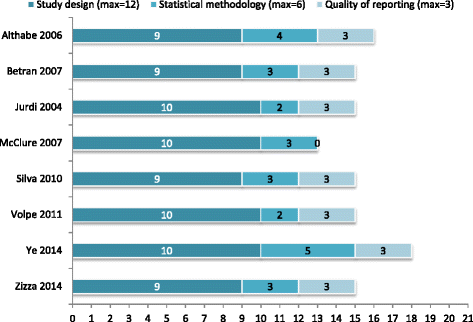What is the optimal rate of caesarean section at population level? A systematic review of ecologic studies
- PMID: 26093498
- PMCID: PMC4496821
- DOI: 10.1186/s12978-015-0043-6
What is the optimal rate of caesarean section at population level? A systematic review of ecologic studies
Abstract
In 1985, WHO stated that there was no justification for caesarean section (CS) rates higher than 10-15% at population-level. While the CS rates worldwide have continued to increase in an unprecedented manner over the subsequent three decades, concern has been raised about the validity of the 1985 landmark statement. We conducted a systematic review to identify, critically appraise and synthesize the analyses of the ecologic association between CS rates and maternal, neonatal and infant outcomes. Four electronic databases were searched for ecologic studies published between 2000 and 2014 that analysed the possible association between CS rates and maternal, neonatal or infant mortality or morbidity. Two reviewers performed study selection, data extraction and quality assessment independently. We identified 11,832 unique citations and eight studies were included in the review. Seven studies correlated CS rates with maternal mortality, five with neonatal mortality, four with infant mortality, two with LBW and one with stillbirths. Except for one, all studies were cross-sectional in design and five were global analyses of national-level CS rates versus mortality outcomes. Although the overall quality of the studies was acceptable; only two studies controlled for socio-economic factors and none controlled for clinical or demographic characteristics of the population. In unadjusted analyses, authors found a strong inverse relationship between CS rates and the mortality outcomes so that maternal, neonatal and infant mortality decrease as CS rates increase up to a certain threshold. In the eight studies included in this review, this threshold was at CS rates between 9 and 16%. However, in the two studies that adjusted for socio-economic factors, this relationship was either weakened or disappeared after controlling for these confounders. CS rates above the threshold of 9-16% were not associated with decreases in mortality outcomes regardless of adjustments. Our findings could be interpreted to mean that at CS rates below this threshold, socio-economic development may be driving the ecologic association between CS rates and mortality. On the other hand, at rates higher than this threshold, there is no association between CS and mortality outcomes regardless of adjustment. The ecological association between CS rates and relevant morbidity outcomes needs to be evaluated before drawing more definite conclusions at population level.
Figures


References
-
- Appropriate technology for birth. Lancet. 1985;2(8452):436–7. - PubMed
-
- Vogel JP, Betran AP, Vindevoghel N, Souza JP, Torloni MR, Zhang J, et al. Use of the Robson classification to assess caesarean section trends in 21 countries: a secondary analysis of two WHO multicountry surveys. The Lancet Global health. 2015;3(5):e260–e270. doi: 10.1016/S2214-109X(15)70094-X. - DOI - PubMed
Publication types
MeSH terms
Grants and funding
LinkOut - more resources
Full Text Sources
Other Literature Sources
Medical

